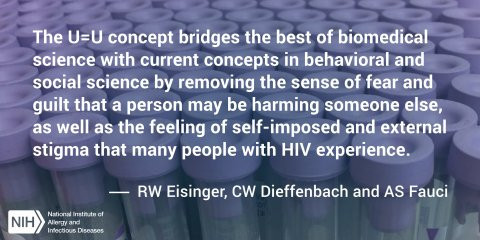In recent years, an overwhelming body of clinical evidence has firmly established the HIV Undetectable = Untransmittable (U=U) concept as scientifically sound, say officials from the National Institutes of Health (NIH).
U=U means that people living with HIV who achieve and maintain an undetectable viral load — the amount of HIV in the blood — by taking and adhering to antiretroviral therapy (ART) as prescribed cannot sexually transmit the virus to others. Writing in the Journal of the American Medical Association (JAMA), officials from NIH’s National Institute of Allergy and Infectious Diseases (NIAID) review the scientific evidence underlying U=U and discuss the implications of widespread acceptance of the message.

NIAID
In the new commentary, NIAID Director Anthony S. Fauci, MD, and colleagues summarize results from large clinical trials and cohort studies validating U=U. The landmark NIH-funded HPTN 052 clinical trial showed that no linked HIV transmissions occurred among HIV serodifferent heterosexual couples when the partner living with HIV had a durably suppressed viral load. Subsequently, the PARTNER and Opposites Attract studies confirmed these findings and extended them to male-male couples.
Validation of the HIV treatment as prevention strategy and acceptance of the U=U concept as scientifically sound have numerous behavioral, social and legal implications, the NIAID officials note. U=U can help control the HIV pandemic by preventing HIV transmission, and it can reduce the stigma that many people with HIV face.
The success of U=U as an HIV prevention method depends on achieving and maintaining an undetectable viral load by taking ART daily as prescribed. Numerous factors, including lack of access to quality health care, can make ART adherence difficult. To enhance the overall success of U=U, the authors emphasize the importance of implementing programs that help patients remain in care and address the barriers to daily therapy.
NIAID conducts and supports research — at NIH, throughout the United States, and worldwide — to study the causes of infectious and immune-mediated diseases, and to develop better means of preventing, diagnosing and treating these illnesses.
NIH, the nation’s medical research agency, includes 27 Institutes and Centers and is a component of the U.S. Department of Health and Human Services. NIH is the primary federal agency conducting and supporting basic, clinical, and translational medical research, and is investigating the causes, treatments, and cures for both common and rare diseases.
For more information about NIH and its programs, visit nih.gov.
This article was originally published at niaid.nih.gov.
To read the JAMA article, click here.
JAMA article: W Eisinger, CW Dieffenbach, AS Fauci. HIV viral load and transmissibility of HIV infection: undetectable equals untransmittable. Journal of the American Medical Association DOI: 10.1001/jama.2018.21167 (2019).







4 Comments
4 Comments